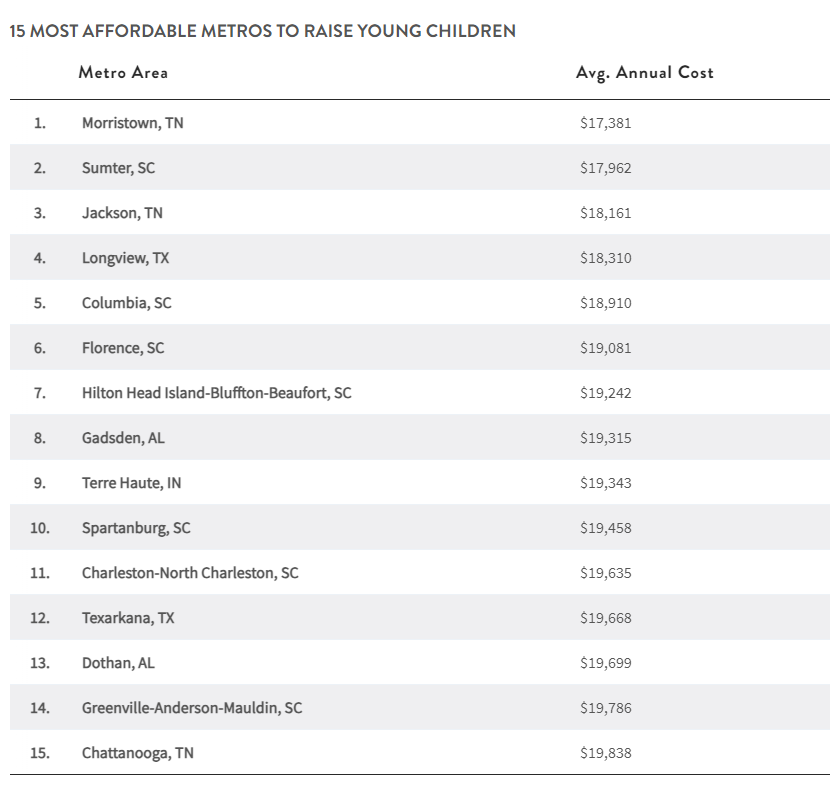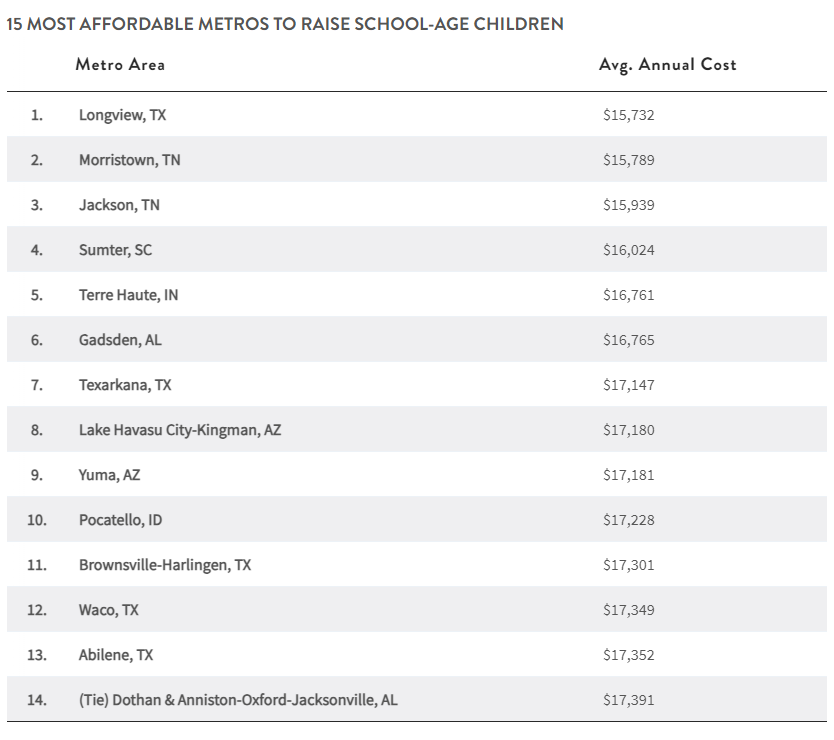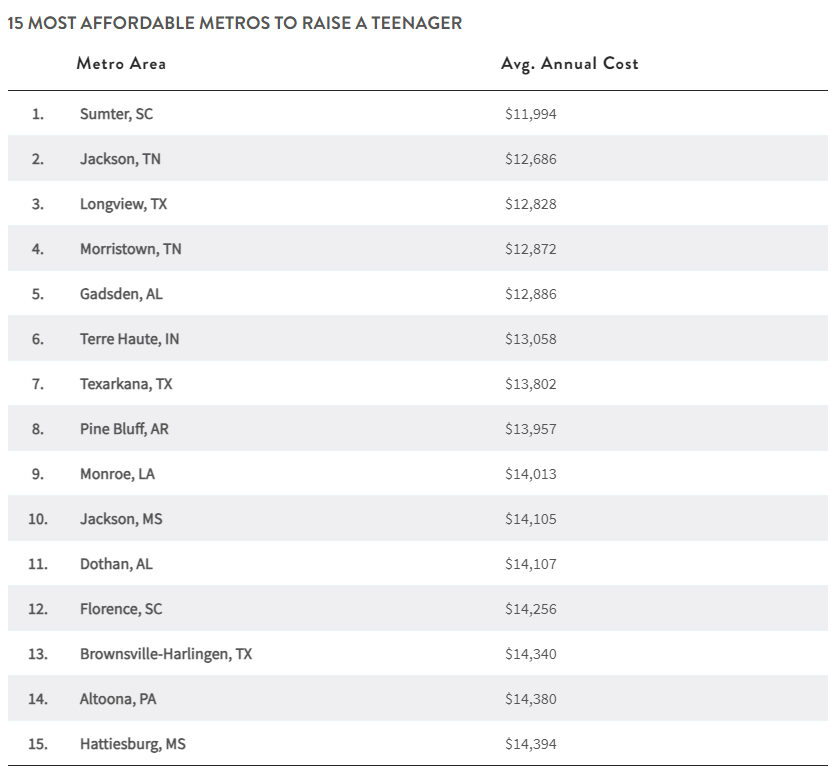Where can parents affordably raise a child from infancy to teenhood?

Canva
Where can parents affordably raise a child from infancy to teenhood?
A couple help their two children with their studies, seated at dining room table
Whether purchasing strollers and diapers or stocking the kitchen for a growing teenager, raising kids costs a pretty penny no matter where you live. With the Bureau of Labor Statistics reporting that consumer spending was up 3.7% in September 2023 compared to the previous year, understanding the cost of living in different areas is more critical than ever for effective family budgeting.
MoneyGeek analyzed data for 381 metropolitan areas from the MIT Living Wage calculator to find the most affordable metro areas for raising children. Analysis discovered that the average family will use at least 19% of their annual income to afford the costs of raising young children to their teenage years. MoneyGeek also found that metro areas in the South tend to have the lowest yearly expenses for raising children, regardless of age.
Key findings
- On average, parents spend $25,610 yearly to raise young children, accounting for 22% of combined income in households with two earners. That number falls to $21,456 for school-age children, while teenagers cost $20,589 annually. For more information about how our analysis defines each of these three stages of childhood, please review the Methodology below.
- Southern metros lead in affordability. Morristown, Tennessee, has the lowest yearly early childhood expenses, under $18,000. Longview, Texas, and Sumter, South Carolina, have the lowest costs for school-age and teenage years, with both having average annual expenses under $16,000.
- While teenagers are generally less expensive to raise than younger children, there are 91 metros where these costs can be up to 43% higher, particularly in Honolulu, Hawaii, and several cities in California.
![]()

MoneyGeek
Best metros for navigating early childhood expenses
A chart of 15 most affordable metros to raise young children
MIT’s Living Wage Calculator defines a “young child” as a child that’s four years old, so the data presented here represents the average expenses associated with raising a four-year-old.
On average, raising a young child costs $25,610 annually, which accounts for about 22% of yearly income in dual-earner households. However, in places like Morristown, Tennessee, and Sumter, South Carolina, this figure drops to below $18,000.
Southern metro areas take 18 of the top 20 spots for affordability. In the Northeast, Pennsylvania’s metros, including Altoona and Johnstown, keep these early childhood expenses under $22,500. Yuma, Arizona, stands out in the West, with an average cost of around $21,388; that annual expense is similar to affordability in Midwestern areas like Terre Haute, Indiana, and Manhattan, Kansas — both with costs under $20,000.

MoneyGeek
Top metros for raising school-age kids
A chart of 15 most affordable metros to raise school-age children
MIT’s Living Wage Calculator defines a “school-age” child as a child that’s nine years old, so the data presented here represents the average expenses associated with raising a nine-year-old.
In the U.S., raising a school-age child costs $21,456 yearly, on average. However, in 213 metro areas, parents can expect to spend less than this. The most affordable areas are Longview, Texas; Morristown, Tennessee; and Jackson, Tennessee, where average annual costs fall below $16,000.
Two Arizona metros (Lake Havasu and Yuma) and Pocatello, Idaho, ranked best in the West. In these Western metros, parents can expect an average of $17,000 annually for children around nine.

MoneyGeek
Cost-effective metros for raising teens
A chart of the 15 most affordable metros to raise a teenager
MIT’s Living Wage Calculator defines a “teenager” as a child who’s 15 years old, so the data presented here represents the average expenses associated with raising a 15-year-old.
For teenagers, parents can expect to spend a few thousand dollars less annually than they did in their childhood, with national average costs around $20,600. Southern metros lead in affordability for raising teenagers, with eight in the top 10. Sumter, South Carolina, has the lowest average annual cost; there, it costs less than $12,000 annually to raise a 15-year-old. Jackson, Tennessee, and Longview, Texas, follow close behind, costing about $1,000 more. Parents in these top areas spend less than 14% of their income on expenses for their teens.
Although teenagers are typically less expensive to raise than younger children, 91 metros see higher costs. The starkest example is Honolulu, Hawaii, where expenses for a 15-year-old reach $34,000. In places like Tucson, Arizona, and Spokane, Washington, the cost gap between a nine-year-old and a teenager is minimal.
From insights to action: What parents can do to raise a family affordably
Various metros across the United States provide a financially favorable environment for growing families, with manageable cost increments as family size increases. The following actionable tips offer a roadmap for growing families to make well-informed decisions in their quest for affordable metro living.
If you’re willing to move, consider metros with:
- Affordable housing costs
Look for metro areas with a favorable home value to annual income ratio. Explore mortgage options to find what fits your budget, and compare mortgage rates to ensure you’re getting the best deal. - Employment opportunities
Seek metros with robust job markets and lower unemployment rates. - Manageable living expenses
Opt for areas with lower percentages of income spent on mortgage payments, rent, and other home-related costs like insurance. Compare home insurance quotes to find the best rates and coverage. - Lower day-to-day costs
Choose metros with lower costs on necessities like food, transportation, child care, and healthcare relative to income.
Methodology
Using the MIT Living Wage Calculator, MoneyGeek analyzed data for 381 metro areas to find the cost of raising a young child, a school-age child and a teenager in each metro.
The MIT Living Wage Calculator defines these childhood stages as follows:
- Young Child: 4 years old
- School-Age Child: 9 years old
- Teenager: 15 years old
The MIT Living Wage Calculator’s assumptions for family composition include a young child in one-child families, a young child and a school-age child for those with two kids, and a young child, a school-age child and a teenager in families with three children. We used these assumptions to calculate the individual annual costs for these childhood stages.
We calculated the average percentage of a family’s annual income that these costs comprised using the average yearly income for a dual-earner family ($117,107) from the U.S. Census Bureau for 2022, the most recent year of data available.
The costs considered are food, childcare, housing, health care, transportation, taxes and other expenses like personal care items, clothing, and more. The data is for 2022, the most recent year of data available.
This story was produced by MoneyGeek and reviewed and distributed by Stacker Media.
